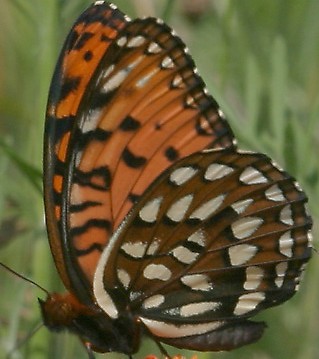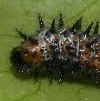 A native of tall and mixed grass prairies, the regal fritillary is found from eastern Montana to Maine south to eastern Colorado and western North Carolina where it lives in wet meadows and other moist open areas. The dorsal side of the forewings is red-orange with blue-black spots and white-dotted black margins. The dorsal side of the hindwings are black with two rows of light cream dots on females and a row of cream and row or orange dots on males.spots. The ventral side of the forewings is similar to the dorsal side, but the ventral side of the hind wings are deep olive-brown with many silver spots. The wing span is 2 5/8 to 3 5/8 inches with females larger (and darker) than males.
A native of tall and mixed grass prairies, the regal fritillary is found from eastern Montana to Maine south to eastern Colorado and western North Carolina where it lives in wet meadows and other moist open areas. The dorsal side of the forewings is red-orange with blue-black spots and white-dotted black margins. The dorsal side of the hindwings are black with two rows of light cream dots on females and a row of cream and row or orange dots on males.spots. The ventral side of the forewings is similar to the dorsal side, but the ventral side of the hind wings are deep olive-brown with many silver spots. The wing span is 2 5/8 to 3 5/8 inches with females larger (and darker) than males. There is one brood a year. Males emerge a week or more earlier in early summer than the females and begin looking for females. After mating the females once the females retreat to the vegetation where they remained concealed for several days after which they emerge and nectar before egg laying in late summer. Each female can lay over 2000 eggs. They lay the eggs singly on vegetation that is usually near but not on the host plant.The eggs hatch in late fall and the newly emerged caterpillars eat the remains of their egg but
There is one brood a year. Males emerge a week or more earlier in early summer than the females and begin looking for females. After mating the females once the females retreat to the vegetation where they remained concealed for several days after which they emerge and nectar before egg laying in late summer. Each female can lay over 2000 eggs. They lay the eggs singly on vegetation that is usually near but not on the host plant.The eggs hatch in late fall and the newly emerged caterpillars eat the remains of their egg but  nothing else, hibernate during the winter, emerge in the spring, and begin feeding on the leaves of violet plants. The mature caterpillars are yellowish-brown with black blotches and lines,yellowish bands, silver spines on the back and orange spines on the sides. They pupate for fifteen days forming a light brown chrysalis with black spots.
nothing else, hibernate during the winter, emerge in the spring, and begin feeding on the leaves of violet plants. The mature caterpillars are yellowish-brown with black blotches and lines,yellowish bands, silver spines on the back and orange spines on the sides. They pupate for fifteen days forming a light brown chrysalis with black spots.
The host plant for the caterpillars are many different kinds of Viola and include V. pedata (bird’s-foot violet), V. pedatifida )blue prairie violet), V. papilionacea (common blue violet_, V. lanceolata (lance-leaed violet, V, nuttallii (Nuttall’s violet), V. sagittata (arowleaf violet), and V. tricolor (Johnny jump up). Of these, Johnny jump up are usually the easiest to find in nurseries and garden centers for garden planting and are excellent front of the border garden plants. The adults nectar on clovers (Trifolia spp), and thistles, plants best grown in a wildflower garden. Garden plants include bergamonts (Monarda spp.), blazing star (Liatris spp.) , coneflower (Echinaea spp.) and goldenrod (Solidago spp.). In addition, some species of ironweed (Veronica spp.) and milkweed (Ascelpius spp) are good choices for the garden, with some more ornamentaly valuable than others.
The regal fritillary is a butterfly worth making a effort to attract if you live in the right environment. In addition to being beautiful, its numbers are steadily declining because of habitat destruction and it needs all the help it can get. The decline ha been greatest in the eastern part of its range and only a few populations still exist there.